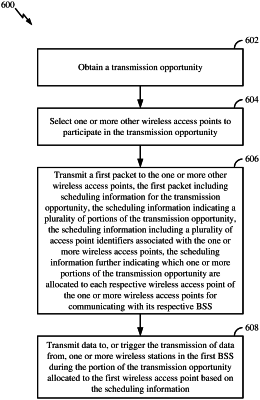| CPC H04W 72/12 (2013.01) [H04W 72/20 (2023.01); H04W 88/08 (2013.01)] | 24 Claims |

|
1. A method for wireless communication by a first wireless station in a first basic service set (BSS) associated with a first wireless access point, the method comprising:
receiving a first packet from the first wireless access point that includes scheduling information for a transmission opportunity obtained by a second wireless access point associated with a second BSS, the scheduling information indicating one or more portions of the transmission opportunity, the scheduling information including one or more access point identifiers associated with one or more respective wireless access points, the scheduling information further indicating which one or more portions of the transmission opportunity are allocated to each respective wireless access point of the one or more wireless access points for communicating with its respective BSS, the one or more portions being nonoverlapping and each portion of the transmission opportunity being allocated to a different wireless access point;
receiving a trigger frame from the first wireless access point in a portion of the transmission opportunity allocated to the first wireless access point; and
transmitting data to the first wireless access point in the portion of the transmission opportunity allocated to the first wireless access point in response to receiving the trigger frame based on the scheduling information including a first access point identifier associated with the first wireless access point, the transmission of the data to the first wireless access point in response to the trigger frame being further based on:
refraining from updating an inter-BSS network allocation vector in association with receiving a second packet that includes the first access point identifier during the transmission opportunity from the second wireless access point, from another wireless access point associated with an access point identifier included in the scheduling information, or from a wireless station in a BSS associated with another wireless access point associated with an access point identifier included in the scheduling information; or
ignoring an inter-BSS network allocation vector in association with the first packet or the trigger frame indicating that no carrier sensing is required for transmission of data to the first wireless access point in the portion of the transmission opportunity allocated to the first wireless access point in response to receiving the trigger frame; or
not updating an inter-BSS network allocation vector and not updating an intra-BSS network allocation vector in association with the scheduling information including the first access point identifier.
|